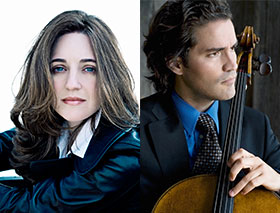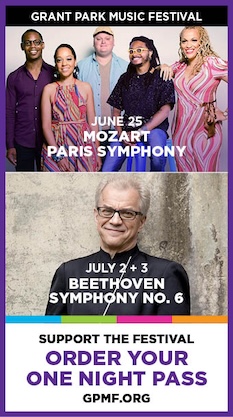Bailey and Dinnerstein take disruptive Ravinia audience on epic Beethoven journey

Tuesday night’s concert at Ravinia’s intimate Bennett-Gordon Hall was notable for some fine music making as well as more than its share of disruptive mishaps. But the music of Beethoven, in the hands of the intrepid Simone Dinnerstein and Zuill Bailey, overcame nearly all obstacles and triumphed impressively.
The young artists set a daunting challenge for themselves: to perform all five of Beethoven’s sonatas for piano and cello in chronological order (the duo’s complete set was recently released on the Telarc label). This makes for a long and rugged journey, although one well worth the attempt. Hearing these important works in context is to experience Beethoven’s three periods in a highly graphic way. Emotionally as well as musically, they cover a lot of ground — the agreeable courtier who dedicated the first two sonatas to the king of Prussia in 1796 is hardy recognizable in the almost brutal composer of the final two sonatas of 1815.
And yet this performance turned up more of the similarities than the differences. Zuill Bailey is a very aggressive performer who is not afraid to express his emotions by his body language. He tore into the first sonatas as if they were late masterpieces, and he underlined passages that almost seemed to anticipate Beethoven’s final period. His long line in the strange opening adagio of the first sonata set the tone for the whole evening.
The virtuoso conclusion of the first sonata boded well too, as these charismatic performers demonstrated an extraordinary musical synergy at the highest speeds. Simone Dinnerstein’s piano was an unfailing delight: her expressive dynamics and masterful technique underpinned the evening. These works were still called sonatas for piano after all, as the cello was just emerging from its chrysalis as a continuo instrument.
It was after the first movement of the first sonata that the trouble started. The audience applauded. They continued to applaud after each movement for the entire first half. Then there was the loud and persistent cell phone. And at the end of the second sonata, there was a pause which turned into a comedy of errors. A good part of the audience got up for intermission and actually left the hall before realizing that the first half wasn’t over, and then trooped noisily back in while Bailey was delivering his most substantial talk about the significance of the program.
Bailey was unfazed and is a natural at handling an audience with his easy sense of humor. “If the phone was for me, tell them I’m busy” he said referring to the annoying cell phone.
And they were indeed very busy last night. To move into the third cello sonata (which is enigmatically titled Inter Lacrimas et Luctum (Amid Tears and Sorrow) is to experience Beethoven at his prime. The work was written when he was composing the Fifth and Sixth symphonies and contains themes echoing some of his middle-period masterpieces like the first Rasoumovsky Quartet or the Seventh Symphony. It is a demanding piece with serious aspirations. The last movement opens with a lyrical adagio which Bailey played with his usual romantic fervor before jumping into another whirlwind finale. It was in all one of the highlights of the evening.
After the real intermission, the tired performers and their remaining audience had to face up to the biggest challenge of all: the two last sonatas, dating from 1815, a time when increasing deafness tormented this already troubled man.
The two sonatas are chips from Beethoven’s latest style, where profound emotion struggles with form and makes something new of it. The artists rallied with the spirit of true professionals and gave these monumental chunks their best efforts. Even if a few notes were missed or smudged and intonation was approximate they had the measure of the music. And when they came to the arid garden that is the last cello sonata, they fully embraced the abstract contrapuntal spirit that looks so far ahead.
Posted in Uncategorized


Posted Aug 27, 2009 at 6:23 pm by jEFF
After the second piece the audience did, indeed, leave the hall. The ushers were telling folks – me, included – that it WAS intermission. Don’t blame the customers: Ravinia staff should have taken charge of the situation and they did not.